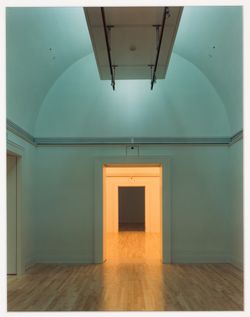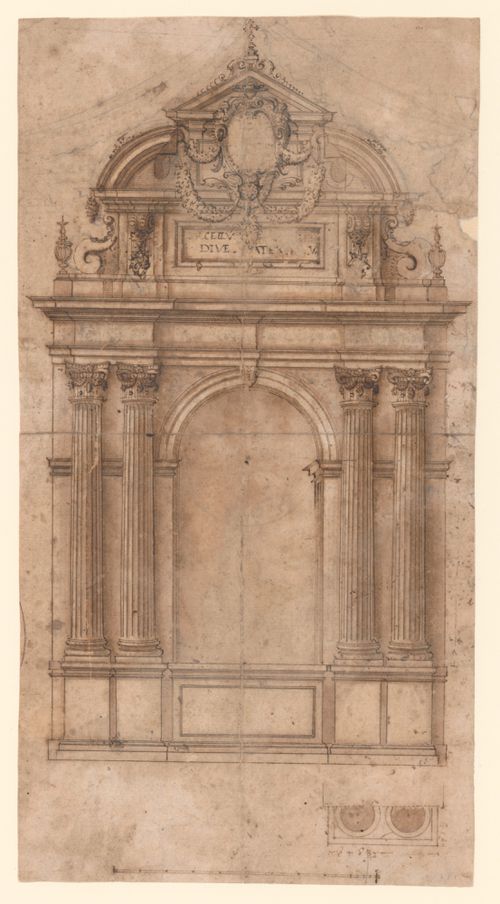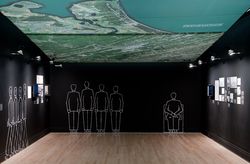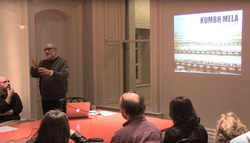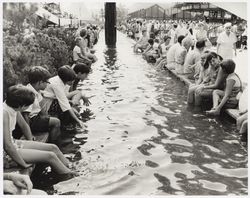Sub-series
Education
CI001.S1.D1
Description:
Hubert Rohault de Fleury studied under Jean-Nicolas-Louis Durand at the École polytechnique and with Julien-David Leroy at the École des beaux-arts. The confluence of their respective pedagogies is evident in albums DR1974:0002:012:001-049 and DR1974:0002:013:001-008 where Durand's` "rationalized" methodology of design is applied to Leroy's vocabulary of antiquity(1). Hubert's two albums of student drawings for the École des Beaux-Arts (DR1974:0002:012:001-049 and DR1974:0002:013:001-008) are complimentary. The former contains competition drawings and programmes for the monthly competitions (Concours d'emulation) as well as drawing, prints, and programmes for the 1800 (2e), 1801, and 1802 (1er) Grand Prix competitions, each of which trace the entire process from "Concours d'essai" and "esquisse", up to and including, studies for final renderings. The latter album contains large-scale final renderings for the 1800, 1801, and possibly the 1798 Grand prix competitions. As in Durand's "mecanisme de la composition", Hubert proceeds from the simple to the complex, often utilizing the graph paper or hand drawn grid particular to Durand's design methodology (codified in his book 'Precis des Lecons' 1802). This process is readily apparent in both Hubert's "Concours d'emulation" drawings, and, more completely, in the drawings for the Grand Prix competitions. The studies for Hubert's winning 1802 Grand Prix entry for a'Foire' indicate that he isolated and studied different building types before combining them into the unified complex evident in his final renderings. The original final renderings of the Grand Prix winners were kept by the École des beaux-arts. Album DR1974:0002:012:001-049 contains only the prints of the final renderings. The success of Hubert in the Grand Prix competitions is not surprising. His large wash final renderings for the 1800 and 1801 competitions (DR1974:0002:013:001-008) indicate that the neo-classical simplicity then favoured by the judges at the École des beaux-arts dovetailed with the notions of economy implicit in Durand's functionalist approach to design. (1) Barry Bergdoll, "Hubert Rohault de Fleury: Architectural Education", 'CCA Research Report', n.d.
1800-1807
Education
CI001.S1.D1
Description:
Hubert Rohault de Fleury studied under Jean-Nicolas-Louis Durand at the École polytechnique and with Julien-David Leroy at the École des beaux-arts. The confluence of their respective pedagogies is evident in albums DR1974:0002:012:001-049 and DR1974:0002:013:001-008 where Durand's` "rationalized" methodology of design is applied to Leroy's vocabulary of antiquity(1). Hubert's two albums of student drawings for the École des Beaux-Arts (DR1974:0002:012:001-049 and DR1974:0002:013:001-008) are complimentary. The former contains competition drawings and programmes for the monthly competitions (Concours d'emulation) as well as drawing, prints, and programmes for the 1800 (2e), 1801, and 1802 (1er) Grand Prix competitions, each of which trace the entire process from "Concours d'essai" and "esquisse", up to and including, studies for final renderings. The latter album contains large-scale final renderings for the 1800, 1801, and possibly the 1798 Grand prix competitions. As in Durand's "mecanisme de la composition", Hubert proceeds from the simple to the complex, often utilizing the graph paper or hand drawn grid particular to Durand's design methodology (codified in his book 'Precis des Lecons' 1802). This process is readily apparent in both Hubert's "Concours d'emulation" drawings, and, more completely, in the drawings for the Grand Prix competitions. The studies for Hubert's winning 1802 Grand Prix entry for a'Foire' indicate that he isolated and studied different building types before combining them into the unified complex evident in his final renderings. The original final renderings of the Grand Prix winners were kept by the École des beaux-arts. Album DR1974:0002:012:001-049 contains only the prints of the final renderings. The success of Hubert in the Grand Prix competitions is not surprising. His large wash final renderings for the 1800 and 1801 competitions (DR1974:0002:013:001-008) indicate that the neo-classical simplicity then favoured by the judges at the École des beaux-arts dovetailed with the notions of economy implicit in Durand's functionalist approach to design. (1) Barry Bergdoll, "Hubert Rohault de Fleury: Architectural Education", 'CCA Research Report', n.d.
File 1
1800-1807
Streetview
Organized in conjunction with the initiative ABC : MTL, Streetview presents the everyday, street-level experience of Montréal throughout the twentieth century. It captures political and cultural change on a human scale with a survey of the city’s commercial, residential, and industrial areas. This overview of Montréal pulled from the CCA collection presents the street as(...)
Octagonal gallery
31 January 2013 to 12 May 2013
Streetview
Actions:
Description:
Organized in conjunction with the initiative ABC : MTL, Streetview presents the everyday, street-level experience of Montréal throughout the twentieth century. It captures political and cultural change on a human scale with a survey of the city’s commercial, residential, and industrial areas. This overview of Montréal pulled from the CCA collection presents the street as(...)
Octagonal gallery
Celebrating the opening of the CCAs new building, Canadian Centre for Architecture: Building and Gardens reveals the potential of a museum of architecture as a statement: about the nature of the works it collects and exhibits; about its role in the life of a culture or a city; and about architecture itself. Both the restoration of the nineteenth-century Shaughnessy House(...)
Octagonal gallery
7 May 1989 to 25 March 1990
Canadian Centre for Architecture: Building and Gardens
Actions:
Description:
Celebrating the opening of the CCAs new building, Canadian Centre for Architecture: Building and Gardens reveals the potential of a museum of architecture as a statement: about the nature of the works it collects and exhibits; about its role in the life of a culture or a city; and about architecture itself. Both the restoration of the nineteenth-century Shaughnessy House(...)
Octagonal gallery
Project
AP018.S1.1980.PR14
Description:
This project series documents the design of the Victoria and Grey Trust Company office in Stratford, Ontario from 1980-1981. The office identified the project number as 8014. This project consisted of the design of an office building and computer center to be the new head office of Victoria and Grey Trust Company. Originally, two schemes were proposed, both with eleven storeys, but the project was eventually scaled back to five storeys with a basement and penthouse. The building was to be located on Erie Street. This project consisted only of the building's design; it was eventually constructed under a different project number assigned by the office, with changes to the design (see project series AP018.S1.1981.PR16 in this fonds). The project is recorded through drawings and textual records dating from 1980-1981. The drawings are all reprographic copies, mostly of details, and are arranged within the textual materials. The textual records consist of correspondence, conference reports, tender documentation, pre-design planning, authority documents, inter-office letters, prequalification records and specifications. Box AP018.S1.1980.PR14.001 contains an index to the textual records, which was created by the office.
1980-1981
Victoria and Grey Trust Company, Head Office Design, Stratford, Ontario (1980-1981)
Actions:
AP018.S1.1980.PR14
Description:
This project series documents the design of the Victoria and Grey Trust Company office in Stratford, Ontario from 1980-1981. The office identified the project number as 8014. This project consisted of the design of an office building and computer center to be the new head office of Victoria and Grey Trust Company. Originally, two schemes were proposed, both with eleven storeys, but the project was eventually scaled back to five storeys with a basement and penthouse. The building was to be located on Erie Street. This project consisted only of the building's design; it was eventually constructed under a different project number assigned by the office, with changes to the design (see project series AP018.S1.1981.PR16 in this fonds). The project is recorded through drawings and textual records dating from 1980-1981. The drawings are all reprographic copies, mostly of details, and are arranged within the textual materials. The textual records consist of correspondence, conference reports, tender documentation, pre-design planning, authority documents, inter-office letters, prequalification records and specifications. Box AP018.S1.1980.PR14.001 contains an index to the textual records, which was created by the office.
Project
1980-1981
DR1969:0016
Description:
- This drawing represents an altar, perhaps a shallow side altar of a type increasingly demanded by the Counter-Reformation cult of saints. The dimensions of the rectangular form between the column pedestals (6 x 3 3/4 piedi, according to scale) are appropriate for an altar table. Freehand perspective on the inside right face of the arch indicates the shallowness of the niche, most likely meant to contain a devotional image in the form of a panel painting. A plan of one pair of the engaged columns figures on the lower right. The cardinal's hat signals a religious patron whose coat of arms once appeared in the now badly- abraded centre of the cartouche.
interior design
16th century
Design for an altarpiece frame
Actions:
DR1969:0016
Description:
- This drawing represents an altar, perhaps a shallow side altar of a type increasingly demanded by the Counter-Reformation cult of saints. The dimensions of the rectangular form between the column pedestals (6 x 3 3/4 piedi, according to scale) are appropriate for an altar table. Freehand perspective on the inside right face of the arch indicates the shallowness of the niche, most likely meant to contain a devotional image in the form of a panel painting. A plan of one pair of the engaged columns figures on the lower right. The cardinal's hat signals a religious patron whose coat of arms once appeared in the now badly- abraded centre of the cartouche.
interior design
The armies of World War Two represented only the tips of colliding icebergs, the belligerent nations which had mobilized and transformed themselves for a global “war of production” of unprecedented scale. Architecture in Uniform: Designing and Building for the Second World War documents the extensive contribution of architecture to the war between the bombings of Guernica(...)
Main galleries
13 April 2011 to 18 September 2011
Architecture in Uniform: Designing and Building for the Second World War
Actions:
Description:
The armies of World War Two represented only the tips of colliding icebergs, the belligerent nations which had mobilized and transformed themselves for a global “war of production” of unprecedented scale. Architecture in Uniform: Designing and Building for the Second World War documents the extensive contribution of architecture to the war between the bombings of Guernica(...)
Main galleries
Ephemeral landscapes and pop-up settlements are continually increasing in scale and challenging the concept of the city as a stable and permanent entity. For this lecture Rahul Mehrotra, principal of architecture firm RMA Architects and Chair of Urban Planning and Design at the Harvard Graduate School of Design, presents his research on a pop-up settlement called the(...)
Shaughnessy House
13 February 2013 to 12 February 2013
Rahul Mehrota: The Case of the Kumbh Mela in India
Actions:
Description:
Ephemeral landscapes and pop-up settlements are continually increasing in scale and challenging the concept of the city as a stable and permanent entity. For this lecture Rahul Mehrotra, principal of architecture firm RMA Architects and Chair of Urban Planning and Design at the Harvard Graduate School of Design, presents his research on a pop-up settlement called the(...)
Shaughnessy House
Sink or Swim
What would a city look like if its infrastructure was waterproof, buoyant and–why not!–amphibious? Given the anticipated rise of sea level at a global scale, the connection between the city and water in all its iterations–oceans, rivers, canals, waterways–is subject to change in the coming years. Montreal will be the playground of this creative laboratory of prototypes(...)
February 2017 to March 2017
Sink or Swim
Actions:
Description:
What would a city look like if its infrastructure was waterproof, buoyant and–why not!–amphibious? Given the anticipated rise of sea level at a global scale, the connection between the city and water in all its iterations–oceans, rivers, canals, waterways–is subject to change in the coming years. Montreal will be the playground of this creative laboratory of prototypes(...)
drawings
DR1988:0433:001
Description:
- One of a group of working drawings for William Burn's October 1849 project for Fonthill House, Wiltshire, a country house designed in the Jacobethan style. This group represents only one of the projects that Burn proposed for Fonthill House; the final project, executed in 1856, was much smaller (Walker, 31, illustrated in Hitchcock, vol. 2, fig. VIII 31). Drawings include plans, elevations, and sections, as well as full-scale drawings of masonry details. Approximately half of the drawings are part of a numbered series from one to twenty-two, while the other drawings, mostly masonry details, were not numbered. These latter drawings are not as carefully finished, and a few are incomplete.
architecture
October 1849
Plan for foundations and drains for Fonthill House
Actions:
DR1988:0433:001
Description:
- One of a group of working drawings for William Burn's October 1849 project for Fonthill House, Wiltshire, a country house designed in the Jacobethan style. This group represents only one of the projects that Burn proposed for Fonthill House; the final project, executed in 1856, was much smaller (Walker, 31, illustrated in Hitchcock, vol. 2, fig. VIII 31). Drawings include plans, elevations, and sections, as well as full-scale drawings of masonry details. Approximately half of the drawings are part of a numbered series from one to twenty-two, while the other drawings, mostly masonry details, were not numbered. These latter drawings are not as carefully finished, and a few are incomplete.
drawings
October 1849
architecture
drawings
DR1988:0433:002
Description:
- One of a group of working drawings for William Burn's October 1849 project for Fonthill House, Wiltshire, a country house designed in the Jacobethan style. This group represents only one of the projects that Burn proposed for Fonthill House; the final project, executed in 1856, was much smaller (Walker, 31, illustrated in Hitchcock, vol. 2, fig. VIII 31). Drawings include plans, elevations, and sections, as well as full-scale drawings of masonry details. Approximately half of the drawings are part of a numbered series from one to twenty-two, while the other drawings, mostly masonry details, were not numbered. These latter drawings are not as carefully finished, and a few are incomplete.
architecture
October 1849
Plan for the basement for Fonthill House
Actions:
DR1988:0433:002
Description:
- One of a group of working drawings for William Burn's October 1849 project for Fonthill House, Wiltshire, a country house designed in the Jacobethan style. This group represents only one of the projects that Burn proposed for Fonthill House; the final project, executed in 1856, was much smaller (Walker, 31, illustrated in Hitchcock, vol. 2, fig. VIII 31). Drawings include plans, elevations, and sections, as well as full-scale drawings of masonry details. Approximately half of the drawings are part of a numbered series from one to twenty-two, while the other drawings, mostly masonry details, were not numbered. These latter drawings are not as carefully finished, and a few are incomplete.
drawings
October 1849
architecture

